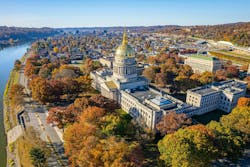The story of a new West Virginia microgrid law–which would allow behind-the-meter microgrids to power data centers and sell 10% of generation into PJM’s wholesale market–began with an effort to lure new businesses to the state.
In 2022, the state recruited BHE Renewables, a subsidiary of Berkshire Hathaway, to come to the state, said James Bailey, an attorney and partner at Spilman Thomas & Battle and former cabinet secretary at the West Virginia Department of Commerce.
The idea was to attract businesses that want to power their operations with renewable energy, said Bailey, who was involved in the recruitment effort.
To help lure those businesses to the state, the legislature passed SB 4001, which created two microgrid districts limited to 2,250 acres each. Two parties–BHE Renewables and Fidelis New Energy–were allowed to deploy microgrids and sell 10% of the power output to PJM. Under the law, the microgrids were required to be powered by renewable energy.
First time third parties can sell electricity to end users
“This allowed third parties to sell electricity to end users for the first time in the state’s history,” Bailey said, noting that the state has regulated, vertically integrated utilities.
In April, the West Virginia Legislature and Gov. Patrick Morrisey passed the latest version of that bill, amending the requirements of the two microgrid districts so that they can use non-renewables to generate electricity. The law added provisions that require microgrids to power “high-impact” data centers.
High-impact data centers have a critical information technology load of 90 MW or above and are placed in service on or after July 1, Bailey said. They are owned, operated or leased by an entity or affiliated group of entities.
In the latest version, the law created an unlimited cap on the number or size of microgrid districts that power data centers. The data centers must consume more than 70% of the power generated inside the microgrid district. Selling electricity produced by the microgrid into the wholesale market is limited to 10% of the microgrid’s output. This applies to both the two existing microgrid districts and the new districts.
Speeding microgrid development with exemptions from state and local regulations
The law exempts entities providing electric service within microgrid districts from certain Public Service Commission of West Virginia measures that focus on rates, certificates of necessity and siting requirements. It also exempts projects from county or municipal ordinances and regulatory systems, Bailey said.
“To help streamline development and give certainty to developers, the law created a designated program within the West Virginia Department of Commerce to help usher the projects through regulatory hurdles,” he said.
Another aim is to encourage data center and microgrid development in West Virginia while preserving the state’s existing coal- and gas-fired generation capacity for grid reliability and economic efforts.
The West Virginia Environmental Council opposed HB 2014, saying it allows data centers to be built anywhere in West Virginia without input from towns and counties. “These centers could create constant noise and light pollution, and there would be nothing you or your community could do to stop it,” the council said.
Sharing property tax revenues with counties and the state
Under the law, data center operators and owners must share the wealth generated by property taxes levied on the data centers.
Tax revenues associated with the increased value created by the data centers will be distributed to county and state funds. Fifty percent of those revenues will go to the state’s Personal Income Tax Reduction Fund, 30% to the county in which the facilities are sited, 10% to counties statewide and 5% to the Economic Grant Fund and the Electric Grid Stabilization and Security Fund, Bailey said.
To protect utilities from losing existing load, the law says that microgrids can’t shift power that’s now on the regulated utility system into the microgrids; instead, microgrids must serve new loads.
“Regulated utilities in West Virginia are very conscious of preserving the regulatory system,” he said. But right now it’s difficult for large users to get high amounts of utility electricity, and the law helps address that challenge.
For now, some of the details of the bill are being worked out by the state, Bailey said.
Two new Oregon laws support microgrid deployment for resilience
While the West Virginia microgrid law focused on attracting new data centers, two new Oregon laws, HB 2065 and HB 2066 aim to improve resilience. Their goal is to protect residents from increasing numbers of outages due to wildfires and storms in the state.
The Oregon laws also give more power to communities that want to build and deploy their own microgrids. The utility business model stands in the way of that goal, supporters of the legislation said.
HB 2065 allows third-party engineers representing communities to conduct studies about interconnection to help overcome bottlenecks in the energy planning process and help projects get built.
Under HB 2066, communities can designate themselves as resiliency corridors. The law requires utilities to work with them as technical partners.
The new laws in West Virginia and Oregon demonstrate how microgrids can address two major challenges facing the U.S.: increasing power demand from data centers and outages sparked by climate-change related storms and wildfires.
About the Author
Lisa Cohn
Contributing Editor
I focus on the West Coast and Midwest. Email me at [email protected]
I’ve been writing about energy for more than 20 years, and my stories have appeared in EnergyBiz, SNL Financial, Mother Earth News, Natural Home Magazine, Horizon Air Magazine, Oregon Business, Open Spaces, the Portland Tribune, The Oregonian, Renewable Energy World, Windpower Monthly and other publications. I’m also a former stringer for the Platts/McGraw-Hill energy publications. I began my career covering energy and environment for The Cape Cod Times, where Elisa Wood also was a reporter. I’ve received numerous writing awards from national, regional and local organizations, including Pacific Northwest Writers Association, Willamette Writers, Associated Oregon Industries, and the Voice of Youth Advocates. I first became interested in energy as a student at Wesleyan University, Middletown, Connecticut, where I helped design and build a solar house.
Twitter: @LisaECohn
Linkedin: LisaEllenCohn
Facebook: Energy Efficiency Markets


